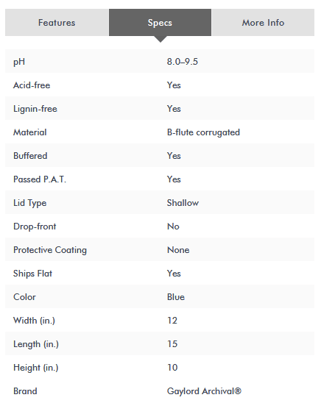 There are basic specifications that apply to archival-quality products. The specifications for archival-quality products that we use are the same as the U.S. Library of Congress.
There are basic specifications that apply to archival-quality products. The specifications for archival-quality products that we use are the same as the U.S. Library of Congress.
To let you know exactly what you're getting, we list specifications for our archival products on the Specs tab of the product pages on our website.
 Important Terms & Definitions
Important Terms & Definitions
- ACID-FREE - Material has a pH of 7.0 or greater at the time of manufacture. Applies to paper & board products.
- LIGNIN-FREE - Material must test negative for lignin, a component of plant cells believed to accelerate chemical degradation. Applies to paper & board products.
- pH - Refers to the pH of the material at time of manufacture. Papers and boards usually test within a pH range. Plastics are not described by pH.
- CONSTRUCTION - Thickness and type of material; point (pt.) and mil are both terms that translate to 1/1,000 of an inch.
- COLOR - Color is only for preference and does not indicate a board's archival quality. All of our boards and papers are archival quality unless specifically noted that the product is recommended for short-term storage only. Our colors do not bleed.
- BUFFER - This indicates whether or not an alkaline substance has been added to neutralize or counteract acids in the future. Some objects may be sensitive to alkalinity and require unbuffered storage materials. Applies to paper & board products. Learn more about buffered and unbuffered materials >
What is the P.A.T.?

The Photographic Activity Test (P.A.T.) is a simulated aging test developed by the Image Permanence Institute to predict which storage materials will cause accelerated deterioration or staining in photos, a very sensitive medium. Most of our storage materials have been submitted and passed the test. Look for this logo on our website.
NOTE: The absence of the logo does not indicate that a product has failed the P.A.T., as some products have not yet been tested.

